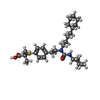Entry Database : PDB / ID : 9iwoTitle X-ray structure of human PPARalpha ligand binding domain-GW7647-PGC1alpha coactivator peptide co-crystals obtained by cross-seeding Peroxisome proliferator-activated receptor alpha Peroxisome proliferator-activated receptor gamma coactivator 1-alpha Keywords / / / / / Function / homology Function Domain/homology Component
/ / / / / / / / / / / / / / / / / / / / / / / / / / / / / / / / / / / / / / / / / / / / / / / / / / / / / / / / / / / / / / / / / / / / / / / / / / / / / / / / / / / / / / / / / / / / / / / / / / / / / / / / / / / / / / / / / / / / / / / / / / / / / / / / / / / / / / / / / / / / / Biological species Homo sapiens (human)Method / / / Resolution : 1.49 Å Authors Kamata, S. / Honda, A. / Yashiro, S. / Komori, Y. / Shimamura, A. / Hosoda, A. / Oyama, T. / Ishii, I. Funding support Organization Grant number Country Japan Society for the Promotion of Science (JSPS) 22K15049 Japan Agency for Medical Research and Development (AMED) JP21am0101071
Journal : Antioxidants / Year : 2025Title : Competitive Ligand-Induced Recruitment of Coactivators to Specific PPAR alpha / delta / gamma Ligand-Binding Domains Revealed by Dual-Emission FRET and X-Ray Diffraction of Cocrystals.Authors : Kamata, S. / Honda, A. / Yashiro, S. / Kaneko, C. / Komori, Y. / Shimamura, A. / Masuda, R. / Oyama, T. / Ishii, I. History Deposition Jul 25, 2024 Deposition site / Processing site Revision 1.0 May 7, 2025 Provider / Type
 Yorodumi
Yorodumi Open data
Open data Basic information
Basic information Components
Components Keywords
Keywords Function and homology information
Function and homology information Homo sapiens (human)
Homo sapiens (human) X-RAY DIFFRACTION /
X-RAY DIFFRACTION /  SYNCHROTRON /
SYNCHROTRON /  MOLECULAR REPLACEMENT / Resolution: 1.49 Å
MOLECULAR REPLACEMENT / Resolution: 1.49 Å  Authors
Authors Japan, 2items
Japan, 2items  Citation
Citation Journal: Antioxidants / Year: 2025
Journal: Antioxidants / Year: 2025 Structure visualization
Structure visualization Molmil
Molmil Jmol/JSmol
Jmol/JSmol Downloads & links
Downloads & links Download
Download 9iwo.cif.gz
9iwo.cif.gz PDBx/mmCIF format
PDBx/mmCIF format pdb9iwo.ent.gz
pdb9iwo.ent.gz PDB format
PDB format 9iwo.json.gz
9iwo.json.gz PDBx/mmJSON format
PDBx/mmJSON format Other downloads
Other downloads 9iwo_validation.pdf.gz
9iwo_validation.pdf.gz wwPDB validaton report
wwPDB validaton report 9iwo_full_validation.pdf.gz
9iwo_full_validation.pdf.gz 9iwo_validation.xml.gz
9iwo_validation.xml.gz 9iwo_validation.cif.gz
9iwo_validation.cif.gz https://data.pdbj.org/pub/pdb/validation_reports/iw/9iwo
https://data.pdbj.org/pub/pdb/validation_reports/iw/9iwo ftp://data.pdbj.org/pub/pdb/validation_reports/iw/9iwo
ftp://data.pdbj.org/pub/pdb/validation_reports/iw/9iwo




 F&H Search
F&H Search Links
Links Assembly
Assembly
 Components
Components Homo sapiens (human) / Plasmid: pET28a / Production host:
Homo sapiens (human) / Plasmid: pET28a / Production host: 
 Homo sapiens (human) / References: UniProt: Q9UBK2
Homo sapiens (human) / References: UniProt: Q9UBK2 X-RAY DIFFRACTION / Number of used crystals: 1
X-RAY DIFFRACTION / Number of used crystals: 1  Sample preparation
Sample preparation SYNCHROTRON / Site:
SYNCHROTRON / Site:  Photon Factory
Photon Factory  / Beamline: AR-NW12A / Wavelength: 1 Å
/ Beamline: AR-NW12A / Wavelength: 1 Å Processing
Processing MOLECULAR REPLACEMENT / Resolution: 1.49→43.24 Å / SU ML: 0.17 / Cross valid method: FREE R-VALUE / σ(F): 1.92 / Phase error: 23.12 / Stereochemistry target values: ML
MOLECULAR REPLACEMENT / Resolution: 1.49→43.24 Å / SU ML: 0.17 / Cross valid method: FREE R-VALUE / σ(F): 1.92 / Phase error: 23.12 / Stereochemistry target values: ML Movie
Movie Controller
Controller


 PDBj
PDBj












